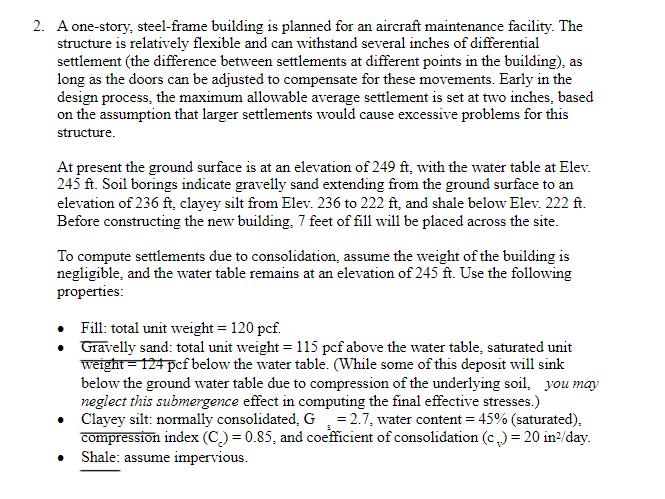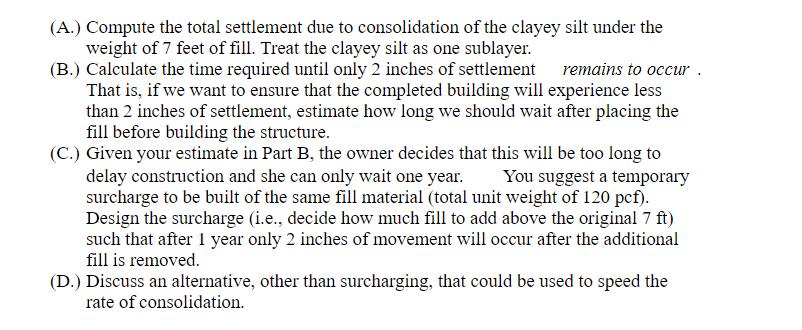Answered step by step
Verified Expert Solution
Question
1 Approved Answer
2. A one-story, steel-frame building is planned for an aircraft maintenance facility. The structure is relatively flexible and can withstand several inches of differential


2. A one-story, steel-frame building is planned for an aircraft maintenance facility. The structure is relatively flexible and can withstand several inches of differential settlement (the difference between settlements at different points in the building), as long as the doors can be adjusted to compensate for these movements. Early in the design process, the maximum allowable average settlement is set at two inches, based on the assumption that larger settlements would cause excessive problems for this structure. At present the ground surface is at an elevation of 249 ft. with the water table at Elev. 245 ft. Soil borings indicate gravelly sand extending from the ground surface to an elevation of 236 ft, clayey silt from Elev. 236 to 222 ft, and shale below Elev. 222 ft. Before constructing the new building, 7 feet of fill will be placed across the site. To compute settlements due to consolidation, assume the weight of the building is negligible, and the water table remains at an elevation of 245 ft. Use the following properties: Fill: total unit weight = 120 pcf. Gravelly sand: total unit weight = 115 pcf above the water table, saturated unit weight =124 pcf below the water table. (While some of this deposit will sink below the ground water table due to compression of the underlying soil, you may neglect this submergence effect in computing the final effective stresses.) Clayey silt: normally consolidated, G = 2.7, water content = 45% (saturated), compression index (C) = 0.85, and coefficient of consolidation (c) = 20 in/day. Shale: assume impervious. (A.) Compute the total settlement due to consolidation of the clayey silt under the weight of 7 feet of fill. Treat the clayey silt as one sublayer. (B.) Calculate the time required until only 2 inches of settlement remains to occur. That is, if we want to ensure that the completed building will experience less than 2 inches of settlement, estimate how long we should wait after placing the fill before building the structure. (C.) Given your estimate in Part B, the owner decides that this will be too long to delay construction and she can only wait one year. You suggest a temporary surcharge to be built of the same fill material (total unit weight of 120 pcf). Design the surcharge (i.e., decide how much fill to add above the original 7 ft) such that after 1 year only 2 inches of movement will occur after the additional fill is removed. (D.) Discuss an alternative, other than surcharging, that could be used to speed the rate of consolidation.
Step by Step Solution
There are 3 Steps involved in it
Step: 1

Get Instant Access to Expert-Tailored Solutions
See step-by-step solutions with expert insights and AI powered tools for academic success
Step: 2

Step: 3

Ace Your Homework with AI
Get the answers you need in no time with our AI-driven, step-by-step assistance
Get Started


